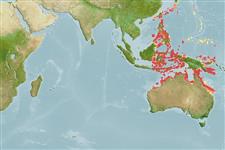>
Gobiiformes (Gobies) >
Gobiidae (Gobies) > Gobiinae
Etymology: Eviota: No etymology given, suggested by Christopher Scharpt: from Latin 'eu' for 'true' and 'iota' for anything very small, in combination 'truly very small' referring to it as being the smallest vertebrate at the time it has benn described by Jenkins (thus, making the suggestion by Scharpt plausible; atriventris: The specific epithet is an adjective combining the Latin atrus (black) and venter (belly), referring to the black pigment in the area of the abdomen (Ref. 89418).
More on authors: Greenfield & Suzuki.
Environment: milieu / climate zone / depth range / distribution range
Sinh thái học
Biển Cùng sống ở rạn san hô; Mức độ sâu 3 - 20 m (Ref. 90102). Tropical; 31°N - 24°S, 116°E - 154°E
Pacific Ocean: Japan (southern Ryukyu Islands), Thailand, Brunei, Malaysia, Philippines, Palau, Indonesia (NW Kalimantan and Bali eastwards), Papua New Guinea, Solomon Islands, south to Australia (Great Barrier Reef) and east to New Caledonia.
Bộ gần gũi / Khối lượng (Trọng lượng) / Age
Maturity: Lm ? range ? - ? cm
Max length : 1.7 cm SL con đực/không giới tính; (Ref. 89418)
Short description
Khóa để định loại | Hình thái học | Sinh trắc học
Các tia vây lưng cứng (tổng cộng) : 7; Các vây lưng mềm (tổng cộng) : 8 - 9; Tia cứng vây hậu môn: 1; Tia mềm vây hậu môn: 7 - 8. This species is distinguished from its congeners by the following set of characters: abdomen with black peritoneum, clearly visible externally; dorsal/anal formula 8/7; simple pectoral-fin rays; length of 5th pelvic-fin ray 40% or greater of 4th ray; genital papilla in male not fimbriate; cephalic sensory-pore system pattern group 2 (only IT missing) (Ref. 89418); characterized further by translucent red with pair of bright yellow stripe behind eye, lower stripe reaching midbody and upper nearly to caudal fin base; fins unmarked; longitudinal scale series 23-24; ctenoid scales, absent on head, nape and pectoral fin base; separated pelvic fins, thin membrane joining bases; 3-5 branches on fourth pelvic ray; depth of body 3.6-4.0 in SL (Ref. 90102).
Lives in small groups near Acropora colonies where it hides when threatened. Feeds on plankton(Ref. 89963). Sometimes solitary, frequently in shady spots near corals (Ref 90102).
Life cycle and mating behavior
Chín muồi sinh dục | Sự tái sinh sản | Đẻ trứng | Các trứng | Sự sinh sản | Ấu trùng
Greenfield, D.W. and T. Suzuki, 2012. Eviota atriventris, a New Goby Previously Misidentified as Eviota pellucida Larson (Teleostei: Gobiidae). Zootaxa 3197:55-62. (Ref. 89418)
IUCN Red List Status (Ref. 130435: Version 2024-1)
Threat to humans
Harmless
Human uses
Các công cụ
Special reports
Download XML
Các nguồn internet
Estimates based on models
Preferred temperature (Ref.
123201): 27.8 - 29.3, mean 28.7 °C (based on 946 cells).
Phylogenetic diversity index (Ref.
82804): PD
50 = 0.5000 [Uniqueness, from 0.5 = low to 2.0 = high].
Bayesian length-weight: a=0.00692 (0.00284 - 0.01683), b=3.10 (2.92 - 3.28), in cm total length, based on LWR estimates for this Genus-body shape (Ref.
93245).
Mức dinh dưỡng (Ref.
69278): 3.0 ±0.3 se; based on size and trophs of closest relatives
Fishing Vulnerability (Ref.
59153): Low vulnerability (10 of 100).
Nutrients (Ref.
124155): Calcium = 585 [228, 2,435] mg/100g; Iron = 2.18 [0.79, 5.51] mg/100g; Protein = 17.4 [15.2, 19.5] %; Omega3 = 0.101 [0.026, 0.413] g/100g; Selenium = 42.2 [8.7, 166.6] μg/100g; VitaminA = 93.4 [13.2, 625.6] μg/100g; Zinc = 6.42 [2.99, 11.85] mg/100g (wet weight);
